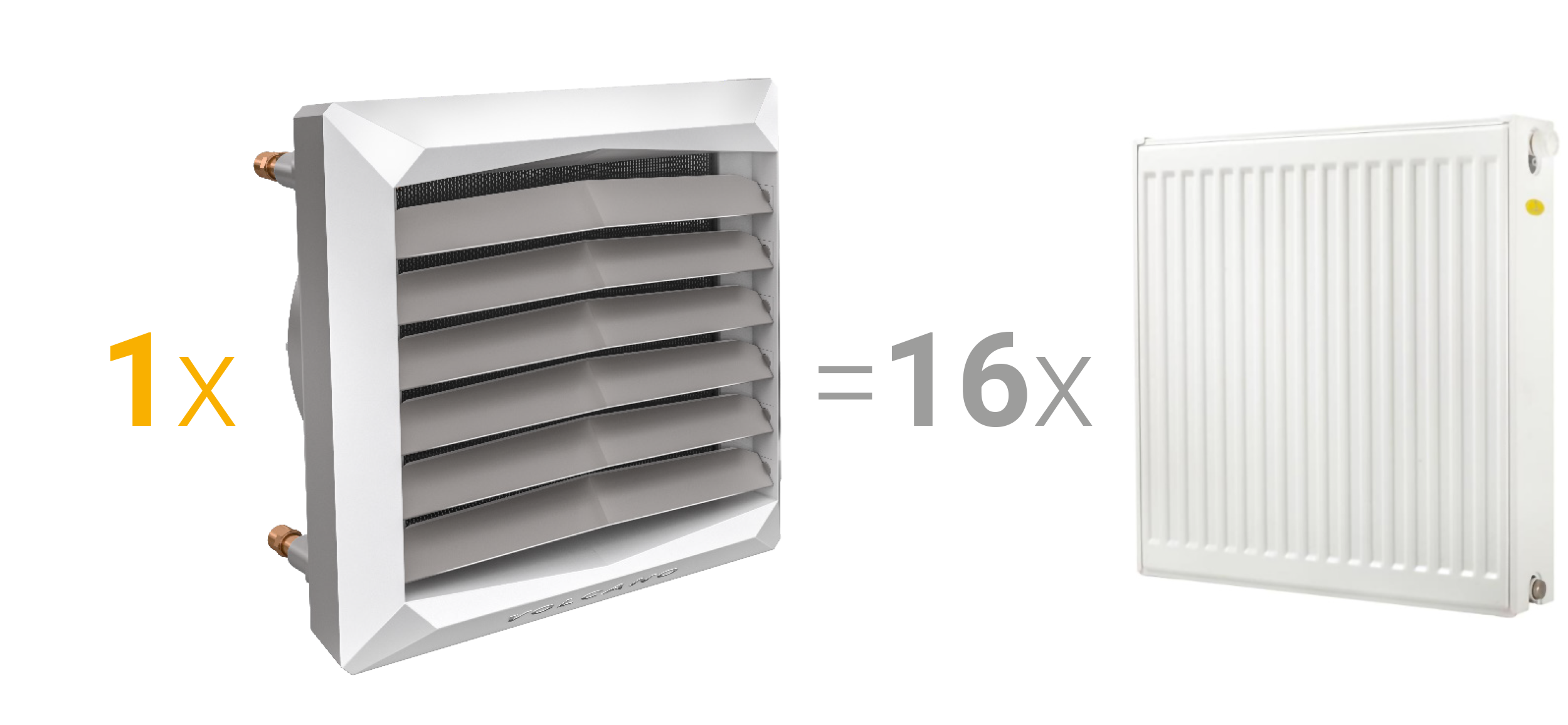Heating unit versus radiator
Imagine that we are planning to heat a small showroom, e.g. a car showroom, and we are faced with the choice of a heating source. The source of heat (in the analyzed case) will be hot water from a boiler, so we consider heating with a traditional radiator or VOLCANO heating units.
In order to make a reliable comparison of both heating methods, it is necessary to assume the conditions and parameters in which the devices will operate. We assume that both solutions are powered by the same heating medium with a temperature of 70/50°C, in a room with the following area:

The desired room temperature is 20°C. Using the formula below we can determine the heat demand of a room, which will amount to 63 kW.
To achieve the above heating value we select two VOLCANO VR3 heating units, which for the assumed operating parameters will reach a total heating power of 70 kW. To achieve the required heating power, we select strong 2 kW radiators in the quantity of 32 pieces.

Comparison of investment costs
The cost of purchasing two VOLCANO VR3 units in an energy-saving EC version with automatic control is 1 193 €. The cost of purchasing 32 pieces of panel radiators from the average price shelf, necessary to heat the site in question, amounts to 2 115 €.
The difference is also visible in the costs of services provided by qualified installers, who make the connection of the heating installations on site. And here, although the unit installation of a heater is about 200 €, and the price of connecting a single radiator is about 25 €, it will cost 400 €
for water heaters and 800 € for radiators, taking into account the whole investment. Both the cost of purchasing the devices and their installation speaks in favor of choosing water heaters. So, let's check if the costs will change during the operation of the building.
Operation of equipment
The third significant factor in the cost comparison between the two heating solutions is the operation. The following operating conditions were assumed for the comparison: 3 years of operation, 5 days a week. The heating season is scheduled for 26 weeks (half a year).
Based on the average price of electricity and the price of hot water from the municipal grid, we estimate the operating costs incurred in the assumed period at 772 € using VOLCANO heating units and 1832 € using classic radiators.
Efficiency of heating
The time required for both solutions to increase the room temperature by 5°C has a major impact on the difference in operating costs. This affects both the heating costs and the comfort of users who have to wait up to 100 minutes for a comfortable temperature in a room with a radiator and less than 40 minutes for water heaters.
Total costs
Knowing the initial costs, the costs associated with the installation and operation of the equipment, we can determine what will be the difference, and thus savings for the user, when he decides to choose VOLCANO heating units with EC motor. The benchmark assumes catalog prices of equipment including discounts) and generally available data on electricity and district heating prices (not including individual contracts with suppliers).
Other aspects worth noting
In addition to the financial benefits, other aspects such as aesthetics and use of space or additional functions are also worth noting.
In the case of the analyzed building, the radiator will be installed almost every 3 meters. This will significantly reduce the possibilities of interior design. We cannot install them in larger groups, because the heating will be inefficient. Heating units are mounted under the ceiling, so they do not take away valuable floor or walls, which gives a lot of freedom in space arrangement. The use of forced air heating, in contrast to a traditional radiator, ensures air circulation and uniform temperature distribution in the room. What is more, we also have the possibility to use the unit to cool down the room in summer.
 English
English Polski
Polski Germany
Germany LATAM
LATAM Bulgaria
Bulgaria Estonia
Estonia France
France Hungary
Hungary India
India Italy
Italy Kazakhstan
Kazakhstan Romania
Romania Czech Republic
Czech Republic Ukraine
Ukraine United Arab Emirates
United Arab Emirates Latvia
Latvia Lithuania
Lithuania United States of America
United States of America
 Turkey
Turkey